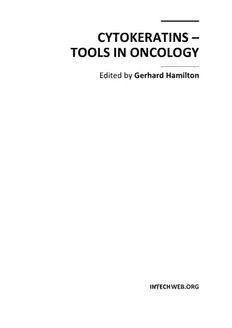
Cytokeratins - tools in oncology PDF
Preview Cytokeratins - tools in oncology
CYTOKERATINS – TOOLS IN ONCOLOGY Edited by Gerhard Hamilton Cytokeratins – Tools in Oncology Edited by Gerhard Hamilton Published by InTech Janeza Trdine 9, 51000 Rijeka, Croatia Copyright © 2012 InTech All chapters are Open Access distributed under the Creative Commons Attribution 3.0 license, which allows users to download, copy and build upon published articles even for commercial purposes, as long as the author and publisher are properly credited, which ensures maximum dissemination and a wider impact of our publications. After this work has been published by InTech, authors have the right to republish it, in whole or part, in any publication of which they are the author, and to make other personal use of the work. Any republication, referencing or personal use of the work must explicitly identify the original source. As for readers, this license allows users to download, copy and build upon published chapters even for commercial purposes, as long as the author and publisher are properly credited, which ensures maximum dissemination and a wider impact of our publications. Notice Statements and opinions expressed in the chapters are these of the individual contributors and not necessarily those of the editors or publisher. No responsibility is accepted for the accuracy of information contained in the published chapters. The publisher assumes no responsibility for any damage or injury to persons or property arising out of the use of any materials, instructions, methods or ideas contained in the book. Publishing Process Manager Martina Durovic Technical Editor Teodora Smiljanic Cover Designer InTech Design Team First published February, 2012 Printed in Croatia A free online edition of this book is available at www.intechopen.com Additional hard copies can be obtained from [email protected] Cytokeratins – Tools in Oncology, Edited by Gerhard Hamilton p. cm. ISBN 978-953-51-0047-8 Contents Preface IX Part 1 Expression of Cytokeratins in Nonmalignant Tissue 1 Chapter 1 The Expression of Cytokeratins in Bovine Intestinal Microfold (M) Cells 3 Takashi Kanaya, Tetsuya Hondo, Kohtaro Miyazawa, Michael T. Rose and Hisashi Aso Chapter 2 Cytokeratins of the Liver and Intestine Epithelial Cells During Development and Disease 15 Priti Chougule and Suchitra Sumitran-Holgersson Part 2 Expression of Cytokeratins in Malignant Tissues 33 Chapter 3 Epithelial to Mesenchymal Transition in Microbial Pathogenesis 35 Abderrahman Chargui, Mimouna Sanda, Patrick Brest, Paul Hofman and Vouret-Craviari Valérie Chapter 4 Cytokeratin 7 and 20 55 Agnieszka Jasik Chapter 5 Cytokeratin 8: The Dominant Type II Intermediate Filament Protein in Lung Cancer 67 Nobuhiro Kanaji, Akihito Kubo, Shuji Bandoh, Tomoya Ishii, Jiro Fujita, Takuya Matsunaga and Etsuro Yamaguchi Part 3 Cytokeratins as Markers of Tumor Dissemination and Response 97 Chapter 6 Cytokeratin 18 (CK18) and CK18 Fragments for Detection of Minimal Residual Disease in Colon Cancer Patients 99 Ulrike Olszewski-Hamilton, Veronika Buxhofer-Ausch, Christoph Ausch and Gerhard Hamilton VI Contents Chapter 7 FISH Probe Counting in Circulating Tumor Cells 119 Sjoerd T. Ligthart, Joost F. Swennenhuis, Jan Greve and Leon W.M.M. Terstappen Chapter 8 Cytokeratin 18 (CK18) and Caspase-Cleaved CK18 (ccCK18) as Response Markers in Anticancer Therapy 135 Hamilton Gerhard Preface The present volume “Cytokeratins – Tools in Oncology” is a new addition to the Intech collection of books that aims at providing scientists and clinicians with a comprehensive overview of specific aspects of the latest research and current knowledge related to the application of cytokeratins in histology, cancer research and clinical diagnosis of tumors. For this purpose a series of research articles, clinical investigations and reviews that deal with the role of the most abundant cytokeratin types in normal and malignant tissues were included. This volume aptly adds to the other Intech titles in the field of oncology, particularly describing advances in cancer therapy, diagnosis and treatment of individual tumor entities as well as the important topic of cancer stem cells. The participating authors shared their expertise about the multiple functions of cytokeratins in organization of the intermediary filaments in normal intestine and liver as well as microfold L cells and, furthermore, the usability of cytokeratins 7, 8, and 20 in tumor diagnosis. Epithelial to mesenchymal transition as a mechanism important in pathogenesis is touched in another chapter, followed by several articles discussing the assessment of cytokeratins in disseminated tumor cells and as response markers during chemotherapy. Our group published reports on the use of cytokeratin fragments in prostate cancer patients undergoing intermittent androgen suppression in the late nineties and it was fascinating to observe the continuative development of anti-cytokeratin reagents as diagnostic and possible predictive tools available in the form of refined assays providing highly valuable means to detect the presence of disseminated tumor cells and minimal residual disease in cancer patients. This book is therefore destined to all cancer researchers and therapists who want to understand the diagnostic use of cytokeratins in histology and especially to tackle the challenge of finding residual tumor cells in patients, either circulating in the blood or residing hidden in niches, that may lead to tumor recurrence and qualify patients for a more aggressive anticancer therapy. As editor of this book, I would like to acknowledge the significant efforts made by all of the contributing authors and the entire editorial team in publishing of this work. I would like to dedicate this book to the “Ludwig Boltzmann Society” and, in particular, to Prof. Dr. Gerhard Baumgartner whose long-standing support has allowed for the X Preface successful realization of many scientific projects. Last but not least, I would like to thank my wife for her personal support and great patience at all times. Gerhard Hamilton, PhD Ludwig Boltzmann Cluster of Translational Oncology, Vienna, Austria
